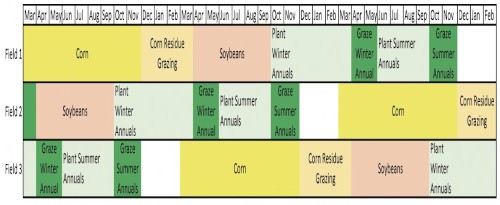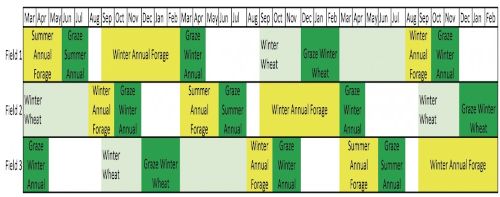By Jay Parsons and John Hewlett et.al
According to the National Agricultural Statistics Service (NASS), approximately 60 million acres of forage are harvested annually in the U.S. Lower commodity grain and oilseed prices coupled with high pasture rental rates and/or difficulty finding range and pasture to rent, have led some crop producers to consider ways to incorporate more annual forages into their crop rotations.
The benefits of adding annual forages to a traditional grain and/or oilseed crop rotation include better ground cover – reducing wind erosion during fallow periods, increases in soil organic matter, better weed control and better soil infiltration rates, which reduce water erosion. In addition, there is the potential to increase income from a given land base by adding forage sales revenue that more than compensates for any increase in costs or decrease in grain and/or oilseed revenues.
If the producer also owns cattle or other ruminant livestock, flexibility emerges on how and when to best utilize the annual forage as feedstuff in order to capitalize on its full value to the agricultural business. The forage can be grazed and/or harvested to be stored and fed to livestock at a later time. Grazing will limit the forage value converted directly to livestock production but provides benefits from nutrient cycling, more ground cover and more organic matter being incorporated into the soil profile.
How best to incorporate annual forage crops into an existing crop rotation will depend upon location, local climate, primary crops and management objectives.
Annual forages can be broken down into three main types: (1) cool-season, winter-hardy (winter types), (2) cool-season, winter-sensitive (spring types) and (3) warm-season, summer annuals.
Winter-hardy forages can be planted in the fall and grazed in winter or early spring. Winter wheat, cereal rye and triticale are three common winter-hardy forages. Winter wheat is often used as a dual-purpose crop with grazing livestock removed early enough in spring to allow for production of a grain crop. Oats, peas and barley are some common spring-type forages. Sorghum, sorghum-sudangrass and millet are common warm-season, summer annuals.
Rotation alternatives
How well annual forages fit into an existing crop rotation will vary. In areas of the country with adequate moisture, it is much easier to intensify a crop rotation by inserting the annual forages into one or more fallow periods. In dryer areas of the country, producers must account for soil moisture conditions and exercise caution in how annual forages are introduced into the rotation.
Figure 1 offers a scenario where a typical two-year corn-soybean rotation is expanded to a three-year rotation, including a double crop of annual forage in the third year.

Bridging the gap for cattle between corn residue grazing in winter and summer pasture is one of the primary objectives. This rotation provides annual forage grazing resources for the critical April-May period in the spring and for the October-November period in the fall. Of course, these forages could alternatively be mechanically harvested and fed throughout the year as needed.
Economically, the producer moving from a two-year corn-soybean rotation to the three-year rotation depicted in Figure 1 would be trading off one-third of the net returns for corn and soybeans for the net benefits of growing two forage crops in one year on a third of their acres. Most people considering this rotation live in the Corn Belt with adequate moisture to support the cropping intensity and possess a desire to improve soil physical properties by growing something other than just corn and soybeans.
Figure 2 depicts a scenario where a typical two-year wheat-fallow rotation is expanded to a three-year crop rotation with up to three annual forages added to the winter wheat rotation.

All of the annual forages in this rotation would be considered “options,” depending upon the prevailing soil moisture conditions, as would grazing of the winter wheat crop during the dormant season.
From a livestock production standpoint, the rotation in Figure 2 potentially provides annual forage-grazing resources year-round. The two grazing gaps that occur in May and the two-month period of August through September could be closed by extending the grazing season of winter-hardy annual forages into May and by using a mix of cool-season and warm-season forages to extend the June-July grazing season into August and September.
In the rotation depicted in Figure 2, each acre would produce a winter wheat crop and one to three annual forage crops every three years. Economically, the producer moving from a two-year wheat-fallow rotation to the three-year rotation depicted in Figure 2 would be trading off one-third of the net returns of growing wheat for the net benefits of growing one to three annual forage crops.
Of course, the intensification of the crop rotation could have a negative impact on wheat yields in low-moisture conditions. However, the rotation is designed to provide flexibility for the producer to adjust the manner in which annual forages are utilized in a given year to match production conditions and, hopefully, mitigate the risk of negatively impacting wheat yields.
Each of the rotations in Figures 1 and 2 provide flexibility for the crop producer to quickly adjust back to the original rotation if market and/or production conditions warrant the change.
Insurance for annual forages
Soil moisture and precipitation present some of the biggest risks when planting annual forages, especially in dryland production situations. The Annual Forage Insurance Plan (AFIP) from the USDA Risk Management Agency (RMA) is a tool that may help mitigate this risk. However, it is currently only available in Colorado, Kansas, Nebraska, New Mexico, North Dakota, Oklahoma, South Dakota and Texas. AFIP insures annual forages, planted for use as livestock feed or fodder, against low precipitation based on precipitation index data provided by the National Oceanic and Atmospheric Administration (NOAA) – Climate Prediction Center.
The annual signup deadline is July 15, with coverage available for four different planting periods that include the entire year. More details on AFIP coverage are available at the RMA website or from a local crop insurance agent.
Source : unl.edu